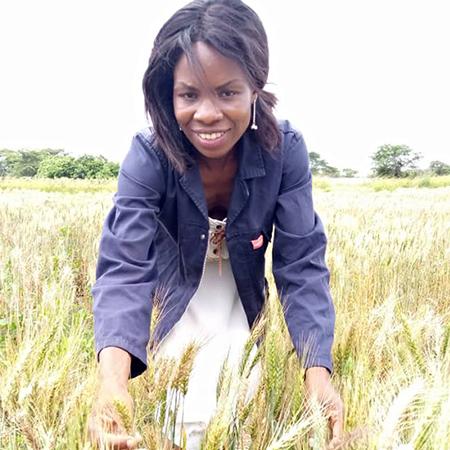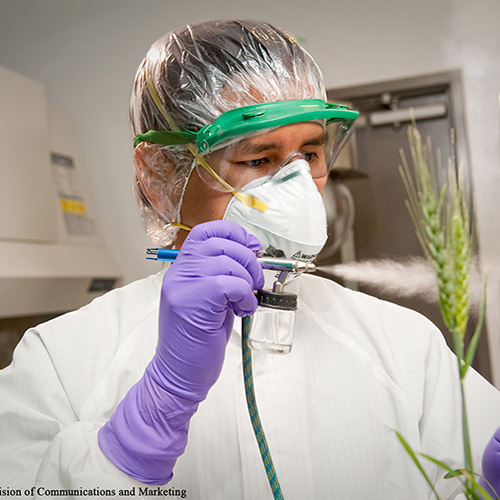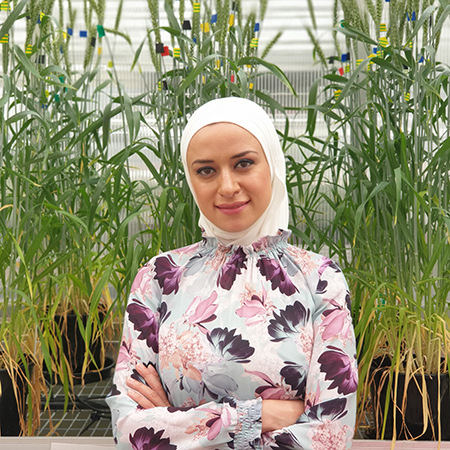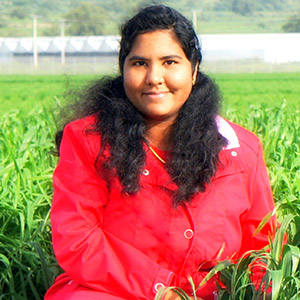- Opening and Welcome
- Keynote: How can epidemiological modelling help prevent rust epidemics?
- Overview of the global wheat rust situation
- Wheat Blast Updates
- New web tools supporting global wheat rust early warning
- Stakeholder driven wheat rust early warning
- Model-guided strategies for in-season scouting and pathogen surveillance for wheat stripe rust in the Central Great Plains region of North America
- An electrochemical DNA biosensor for Yellow rust detection in wheat
- Flash Talks
Opening and Welcome

Maricelis Acevedo, Cornell University, Department of Global Development
How can epidemiological modelling help prevent rust epidemics?
8:05am EDT

Christopher Gilligan, University of Cambridge
ContactBiography: Professor Chris Gilligan is currently director of research and head of the Epidemiology and Modelling Group at the University of Cambridge. Together with his research group and colleagues, Gilligan has developed an extensive epidemiological toolkit with applications in plant and animal disease, including Covid-19. His current research is focused on the development and use of models to predict spread and identify effective strategies for the control of crop disease at scales ranging from on-farm to the landscape, regional and continental scales. Current applications involve models to inform the surveillance and control of crop disease and pests in sub-Saharan Africa (wheat rusts, cassava and banana disease and desert locust), Australia (banana and avocado disease) and India (aflatoxins on maize), Nepal and Bangladesh (wheat rusts) the US (citrus disease) and UK (range of crop and diseases of natural vegetation).
He has published more than 250 research papers and reviews. He has held a UK National Research Council Professorial Fellowship and a Royal Society Leverhulme Trust Senior Research Fellowship, and is an Honorary Fellow of the American Phytopathological Society and former President of the British Society for Plant Pathology. He was awarded a CBE in the Queen’s Birthday honours in 2015 for services to plant health in the field of epidemiology.
Overview of Current Rust Situation and Surveillance Systems
8:45am EDT

Dave Hodson, CIMMYT
ContactAbstract forthcoming
Wheat Blast Updates
9:00am EDT

Batiseba Tembo, Zambia Agricultural Research Institute
ContactWheat Blast in Zambia
Wheat blast caused by Magnaporthe oryzae pathotype Triticum is a destructive disease of wheat particularly in warmer and humid environments. It causes significant yield losses and poor grain quality with low test weight. In Zambia, wheat blast symptoms were first observed during 2017/2018 rainy season making it the first report in Zambia and Africa. The disease occurred again in 2018/2019 season but severity was low due to unfavourable (hot and dry) climatic conditions for disease proliferation. During 2019/2020 rainy season, severity was high as conditions were favourable for disease development. Higher disease severity and yield loss was observed in Coucal and Kwale, indicating inadequate levels of resistance to blast in these local varieties. Wheat blast is a new disease in Zambia, continued effort to identify resistant sources to be used in breeding programme to combat the deadly disease is essential. Currently, screening wheat germplasm to identify resistant genotypes is underway.

Christian Cruz, Purdue University
ContactWheat Blast: epidemiological lessons learned in South America
Wheat blast, caused by Magnaporthe oryzae Triticum pathotype (MoT), has caused widespread losses in South America and South Asia. The recent report in Zambia, Africa, demonstrates the threat of the global spread of this intractable and dangerous disease. Overall, wheat blast is an understudied disease, and a lack of sound frameworks to understand wheat blast epidemics has made its management a challenging task. Results obtained after more than a decade of working on critical knowledge gaps in wheat blast epidemiology will be shared. Results will include our understanding of wheat blast epidemics from experiments conducted in Bolivia and Brazil under field epidemic conditions.
New web tools supporting global wheat rust early warning
9:10am EDT

Jens Grønbech Hansen, Aarhus University
ContactEarly warning requires immediate or short-term actions and alerts (1 day- few month) e.g. an effective system for collecting disease surveillance and sampling data, fast and reliable characterization of pathogen samples and effective coordinated communication and dissemination of results. Early warning may also include longer term actions (6-18 months) e.g. assessment of the epidemic potential of new emerging races, accelerated breeding for resistance, adaptation of IPM based prevention and control strategies and dissemination of synthesised and integrated results via stakeholder networks and academia articles, workshops and conferences. This presentations will present “what did we learn” from new web based early warning tools developed in the frame of AGG and RustWatch. For early season surveillance of rust diseases in Europe we developed a smartphone crowdsource App and an associated Dashboard. Data indicating the local disease pressure from approximately 100 official variety testing trial sites (VCU) were integrated with disease survey data on the same maps and charts. Trap nurseries defined by RustWatch and laid out at the VCU trial sites effectively contributed to “hunting the new” races in Europe. Stem rust is spreading into new regions in Europe (south to north) and results from a network of field nurseries indicated that a majority of cultivars grown in the North are susceptible to SR races currently present in the South. A Field Nursery Data Management System manage all data, analyse and visualise data in collaboration research partners and 12 breeding companies in Europe. In the Frame of AGG we further developed the Vulnerability Mapping Tool for YR and SR races in Ethiopia. A new YR race with the preliminary name PstS16 moved from Central Asia to Ethiopia and now covers approximately half of the population. The web-tool indicate the distribution of varieties in the country, and which areas are vulnerable for severe epidemics in the up-coming main growing season. The presentation will discuss how such integrated web tools effectively can support early warning at all stages and our experiences so far.
Stakeholder driven wheat rust early warning
9:20am EDT

Mogens Hovmøller, Aarhus University
ContactA new approach for stakeholder driven wheat rust early-warning was launched in Europe in 2018. The initiative is based on intensified collaboration between partners within plant pathology, breeding, agronomy, agro-chemistry, molecular genetics and Information and Communication Technologies (ICT). A core activity is to provide a better understanding of pathogen biology and drivers by faster and more efficient diagnostic methods to detect new rust races and genotypes, to use them to investigate population genetic changes in Europe, to study the role of pathogen aggressiveness and temperature adaptation as epidemic drivers and to study the role of Berberis spp. as alternate host for rust fungi in Europe. This has been possible by strengthening the collaboration among European rust diagnostic laboratories, e.g., new procedures for alignment of experimental procedures and interpretation of results, and exchange and compilation of genotypic and phenotypic data using the facilities provided by the WheatRustToolbox. Disease prevention by host resistance is another focus area, providing new knowledge about rust resistance specificities in European wheat germplasm to all three wheat rust fungi, e.g., by integrating epidemiological assays (in vivo) and SNP genotyping for a large number of rust resistance genes. This also involves new approaches for off-season assessment of host resistance using new improved laboratory inoculation and microscopy techniques, and analyses of the impact of resistance gene diversification for preventing rust epidemics at field and landscape scales. The integration with existing stakeholder networks has a high priority, e.g. to increase the expertise and efficiency in rust monitoring within plant breeding, agrochemical industry, agricultural advisory services, and Value for Cultivation and Use (VCU) approval in cereals. The early warning system is implemented in five case study regions, which support development and validation of the systems in collaboration with a wide array of stakeholder groups. Agricultural advisers are involved in disease surveillance and rust sampling for later diagnosis, and giving feed-back about potential barriers in adopting the system. The case study approach will allow us to investigate the threats of invasive rust races at the regional scale and suggest IPM-based prevention and control options adjusted to the relevant agronomical practices and environmental conditions in the considered region. The Wheat Rust Toolbox plays a decisive role for storage, analyses and dissemination of results from the project, which is based on database driven information systems, web tools and mobile platforms. Data management is in accordance with the H2020 Guidelines on FAIR Data Management. RustWatch is funded by the European Union’s Horizon 2020 research and innovation programme (grant agreement 773311), engaging 12 universities/research institutes, 5 agricultural advisory services, and 7 SMEs/industries in Europe.
Model-guided strategies for in-season scouting and pathogen surveillance for wheat stripe rust in the Central Great Plains region of North America
9:30am EDT

Erick DeWolf, Kansas State University
ContactDuring the past two decades, the winter wheat producing areas of the Central Great Plains region in North America have experienced frequent, severe yield losses to stripe rust (yellow rust) Puccinia striiformis f.sp.tritici. Many wheat disease experts indicate that disease outbreaks in the Central Great Plains are influenced by environment and the pathogen populations in the Southern US, particularly within the state of Texas. The challenge, of course, is that the state of Texas covers a large geographical area (approximately 678,000 square km) making systematic, annual survey impractical and costly. Therefore, the objective of this study was to identify areas and time periods in Texas that are most likely influence the development of stripe rust epidemics, and could become a focus for disease and pathogen surveys. Data used in this analysis consisted of monthly summaries of temperature, precipitation and soil moisture from 10 climate reporting districts in the state of Texas. These environmental variables were paired with estimates of wheat yield losses to stripe rust in Kansas, 2000-2019. In this analysis, severe yield loss (>4% statewide yield loss on susceptible varieties) was coded as a binary variable where 1 is considered an epidemic. Nonparametric correlation analysis and logistic regression where used to identify climate reporting districts and time periods consistently associated with regional disease outbreaks and model the risk of yield losses. Results of this study indicated that epidemics of stripe rust and yield losses in Kansas were correlated with environment in climate districts in central and southcentral Texas. Logistic regression models further identified that soil moisture within 2 to 3 climate districts were particularly influential in the development of regional stripe rust epidemics. Soil moisture conditions in Nov and Feb had the strongest relationship with disease. The identified climate districts are 700-1000 km away from Kansas where the disease intensity and yield losses occurred. These time periods precede severe disease in Kansas by 3-6 months. These models could improve the efficiency of in-season disease scouting, and pathogen surveillance by directing monitoring activities to epidemiologically important source regions and critical time periods. In an age of diminishing resources, such model-guided surveillance strategies could help ensure the sustainability of efforts to monitor pathogen populations and provide in-season warnings of disease risk that support disease management decisions by wheat growers.
An electrochemical DNA biosensor for Yellow rust detection in wheat
Rizwana Rehsawla, CCS Haryana Agricultural University
ContactYellow (or stripe) rust caused by Puccinia striiformis F. sp. Tritici (Pst), is an airborne disease of wheat causing yield losses worldwide. The yellow rust spores travel longer distance and the ability of pathogen to mutate and multiply makes it a devastating disease. Use of conventional plant breeding and pathology assays led to wheat improvement for yellow rust, however these are time consuming and cumbersome. Therefore, it is important to develop a cost-effective, non-invasive, sensitive and accurate assay for early detection of yellow rust. Biosensors have been used for detection of human and animal diseases. However, reports on plant pathogen detection using biosensors are limited. Immunological assays have been used as diagnostics, recently DNA based biosensor are in demand due to their sensitive and accurate detection of DNA target sequences. For the detection of yellow rust we have fabricated NiO/ITO thin film based matrix for developing highly sensitive DNA biosensor for detecting this disease. A number of ss-DNA oligonucleotide sequences related in pathogenesis of yellow rust have been employed as probes for sensing. These were immobilized over the surface of Ni/ITO electrode via. physical adsorption. The ss-DNA/NiO/ITO bio electrode response studies were performed using cyclic voltammetry (CV) and differential pulse voltammetry (DPV) in the methylene blue (MB) mediated buffer. Linear response over wide DNA concentration range was obtained with a high sensitivity.
Monitoring for rust disease infections in various wheat fields across Iraq
Emad Al-Maaroof, University of Sulaimani
The role of sexual cycle in variation of the stem rust pathogen
Pablo Olivera, University of Minnesota
Day 2
8am EDT (UTC-4) October 7, 2021
Next-Gen Researchers
- BGRI Legacies: A conversation with Ronnie Coffman and Kathy Kahn
- WIT Awards Ceremony
- Keynote: The importance of including gender and household considerations for plant health interventions
- A data-driven, decentralized breeding approach (3D-breeding) to support genetic gains in challenging cropping environment
- Fostering modern wheat varieties at the farmers’ field in India – An experimental approach
- The tan spot pathogen (Pyrenophora tritici-repentis) in Tunisia: Characterization and comparison with global pathogen collections
- Flash Talks
BGRI Legacies: A conversation with Ronnie Coffman and Kathy Kahn

BGRI Legacies: A conversation with Ronnie Coffman and Kathy Kahn
Women in Triticum Award Ceremony
8:50am EDT
The Jeanie Borlaug Laube Early Career Award, established in 2010, provides professional development opportunities for women working in wheat during the early stages of their career. The award is named after Jeanie Borlaug Laube, mentor to many, and daughter of Nobel Laureate Dr. Norman E. Borlaug. Jeanie Borlaug Laube has served as Chair of the Borlaug Global Rust Initiative since October 2009. Recipients of the Jeanie Borlaug Laube WIT Early Career award will be supported to participate in the International Wheat Congress in 2022 in China.
The Jeanie Borlaug Laube Mentor Award, established in 2010 and first awarded in 2011, recognizes mentors of both genders who have proven to be excellent mentors of women working in triticum and its nearest relatives. The award is named after Jeanie Borlaug Laube, mentor to many, and daughter of Nobel Laureate Dr. Norman E. Borlaug. Jeanie Borlaug Laube has served as Chair of the Borlaug Global Rust Initiative since October 2009. Recipients of the WIT Mentor award will receive a cash honorarium of $3,000 USD.
Learn MoreThe importance of including gender and household considerations for plant health interventions
9:00am EDT

Nozomi Kawarazuka, CIP
ContactBiography: Nozomi Kawarazuka is a social anthropologist at the International Potato Center, based in Hanoi, Vietnam. She conducts a wide range of interdisciplinary agricultural research, such as understanding the social and gender dimensions of technology adoption, labour and cropping systems, and intersectional constraints of women, youth and ethnic minorities in agriculture. Her research also draws on political economy and political ecology from gender perspectives to understand the processes of marginalization and exclusion in rapidly changing urban and rural food systems. Her current regional focus is Southeast and South Asia. She has a Ph.D. from University of East Anglia, UK.
A data-driven, decentralized breeding approach (3D-breeding) to support genetic gains in challenging cropping environment
9:45am EDT

Matteo Dell’Acqua, Scuola Superiore Sant’Anna
ContactThe climate crisis calls for fast and accurate development of improved crop varieties with local adaptation. In smallholder cropping systems worldwide, an estimated 500 million farmers support the livelihoods of up to 2 billion people. Here, heterogenous cropping environments with limited buffering capacity may lead to uneven agronomic performance of varieties currently produced by breeding. In order to fully harness the potential of breeding driven by genomic selection (GS) in smallholder farming settings, genetic diversity data must be coupled with phenotypic data that is truly representative of farmer fields. Here, we present a data-driven decentralized breeding approach called 3D-breeding that leverages crowd-sourced observations of crop performance in farmer fields to enhance the accuracy of GS. 3D-breeding uses a ranking order approach based on a Plackett-Luce model to estimate the worth of genotypes and efficiently predict performance in unobserved farmer fields. We developed 3D-breeding using the case study of durum wheat in the Ethiopian highlands, collaborating with hundreds of smallholder farmers who are expert in wheat cultivation. We selected and genotyped a collection 400 durum wheat landraces and improved varieties representing the agrobiodiversity of Ethiopian durum wheat. The collection was characterized for agronomic performance in experimental stations in Ethiopia following a centralized breeding scheme, then a subset of the collection was tested in 3D-breeding to bring the selection in in farmer fields. Each of 1,165 smallholder farmers across Ethiopia was asked to grow a different combination of four varieties from the subset in their own fields. At the end of the growing season, we collected farmers’ decentralized preferences and we measured grain yield in their plots. We tested the prediction accuracy of wheat performance achieved by 3D-breeding against a benchmark representing a centralized GS approach trained on station data. We found that 3D-breeding could double the accuracy of GS for durum wheat yield in smallholder farmer fields. We tested 3D-breeding against different competitive GS scenarios, showing that our method maintained an edge for prediction accuracy also for farmers’ appreciation, a major driver of varietal uptake. 3D-breeding could consistently predict yield and farmers’ appreciation across different seasons and, if used for varietal selection, would prioritize different wheat genotypes from those currently recommended for the area. The advantage of 3D-breeding lies in capturing the broad diversity of farmer fields and end user needs in a big data dimension, providing a better representation of the local growing conditions that are targeted by breeding programs. We discuss the value of our decentralized method beyond the durum wheat case study as a cost-effective and efficient complement to breeding for challenging cropping environments.
Fostering modern wheat varieties at the farmers’ field in India – An experimental approach
10:00am EDT

R. Sendhil, ICAR-Indian Institute of Wheat and Barley Research
ContactSeed is the most crucial input in crop production and serves as a prime channel for technology (variety) dissemination. Despite rigorous efforts to promote the modern wheat varieties in India, the seed and varietal replacement rates are low, barring a few regions like Punjab and Haryana. To counter this, inter alia, frontline demonstration (FLD) – an extension method wherein the recent varieties (treatment) are demonstrated at the farmers’ field along with their preferred variety (control) in the same piece of land for evaluation – has been widely advocated. The purpose of the FLD is to increase the awareness of recent varieties for harnessing the yield potential. It also gives an opportunity to the beneficiaries in understanding the complete package of practices involved with the demonstrated technology under the guidance of experts that gets reflected on the profitability and welfare of the farmers. In the milieu, we evaluated the impact of the recently released wheat varieties (including rust resistant, biofortified, saline tolerant, etc.) demonstrated at the farmers’ field in India. Using an experimental approach, the seeds of the newly released 38 wheat varieties suited to different production conditions were offered and demonstrated during 2019-20 crop season at randomly selected 1607 farmers’ fields across India covering 19 states from 5 wheat growing agro-climatic zones. Analysis of the yield gap, using the survey data from the 85 cooperating centers, indicated a significant difference ranging from 5.51% to 59.52% between the demonstrated plot (treatment: modern variety) vis-à-vis check plot (control: farmers’ choice of variety). The level of yield gap was higher in the hilly and eastern regions of India. Among the demonstrated varieties, ‘Hybrid Indore 8759’ (short as HI 8759), a durum wheat variety demonstrated in Madhya Pradesh (Central Zone) registered the highest yield level (7700 kg/ha) with an estimated yield gain of 32.76% over the control. The gross margin analysis supported the positive effect of demonstrations with an incremental benefit estimated at ₹ 11687 (~158US$) per hectare. We also fitted a profit function (regression analysis) to capture the impact of the demonstration using wheat-growing zones as a dummy variable along with other socio-economic factors. The results indicated that the profit levels are influenced by the market price of the harvested produce, and the region wherein the variety is demonstrated. The cost of variable inputs has been a major constraint in the adoption of the technology. Clearly, our analysis affirms the positive impact of the demonstration at the farmers’ field. Such demonstrations have to be continued for improving the socio-economic status and livelihood of the farmers, especially the vulnerable groups and include disadvantaged regions like northeast India wherein the recent varieties adoption is substantially low.
The tan spot pathogen (Pyrenophora tritici-repentis) in Tunisia: Characterization and comparison with global pathogen collections
Marwa Laribi, University of Alberta
ContactTan spot, caused by Pyrenophora tritici-repentis (Ptr), is a major foliar disease of wheat. A collection of Ptr isolates from Tunisia, one of the main secondary centers of diversification of durum wheat, was tested for phenotypic race classification based on virulence on a host differential set consisting of four hexaploid wheats (‘Glenlea’, 6B662, 6B365 and ‘Salamouni’), and for the presence of the necrotrophic effector (NE) genes ToxA, ToxB, and toxb by PCR analysis. While races 2, 4, 5, 6, 7, and 8 were identified according to their virulence phenotypes, with races 5 and 7 predominant, PCR testing indicated the presence of ‘atypical’ isolates that induced necrosis on the wheat differential ‘Glenlea’, but lacked the expected ToxA gene. This suggested the involvement of other NEs in the Ptr/wheat interaction responsible for symptom development. Genetic diversity and the Ptr population structure were explored further through the evaluation of 59 Tunisian isolates and 35 isolates from Algeria, Azerbaijan, Canada, Iran, and Syria using 24 simple sequence repeat markers. Average genetic diversity, overall gene flow and percentage polymorphic loci were estimated as 0.58, 2.09, and 87%, respectively. Analysis of molecular variance showed that 81% of the genetic variance occurred within populations and 19% between populations. Cluster analysis by the unweighted pair group method indicated that ToxB- isolates grouped together and were distantly related to ToxB+ isolates. Based on Nei’s analysis, the global collection clustered into two distinct groups according to their region of origin; the Algerian, Azerbaijani, Canadian, and Iranian populations of Ptr clustered together and separated from the Tunisian and Syrian isolates. The results suggest that both geographic origin and the host-specificity imposed by different NEs can lead to differentiation among Ptr populations.
Breakdown of wheat yellow rust disease under Moroccan environment during 2014-2015 cropping seasons and the genomic regions associated with the new virulence
Samira El Hanafi, ICARDA
Breeding for rust resistance through integration of marker assisted gene selection and doubled haploid (DH) production technology in Wheat
H. Prasanth Babu, Indian Agricultural Research Institute
Wild wheat relatives – a unique source of host rust resistance and the introduction of new ideotypes in current cultivated bread wheat
Muhammad Javaid
Genome-wide association mapping of yellow rust resistance in Nordic spring wheat collections
Min Lin, Norwegian University of Life Sciences
Identification of a novel leaf rust and stripe rust resistance gene from Sharon goatgrass
Anna Minz-Dub, Tel Aviv University
Discovering the suppressed resistance in wheat lines for stem and leaf rust diseases
Jyoti Saini Sharma, AAFC
Complementation of the BED domain containing wheat stripe rust resistance gene candidates Yr5(Yr5a) and YrSP(Yr5b)
Jianping Zhang, CSIRO
Day 3
8am EDT (UTC-4) October 8, 2021
Emerging Breeding Technologies
- Gene Stewardship Ceremony
- Keynote: Orchestrating new solutions for faster genetic gains and improved wheat seed delivery
- Breeding nutritious and climate resilient wheat by integrating phenomics, genomics and environmental data
- Comparing simple and complex approaches of environmental suitability model methods for wheat rust
- Data-driven line advancement and parental selection decisions in the CIMMYT bread wheat breeding program
- Flash Talks
- BGRI Trivia
- Closing Ceremony
Gene Stewardship Ceremony
The BGRI Gene Stewardship Award, or “Norman” as it is called, was established in 2012, and is presented annually to recognize a team of researchers serving a national breeding program or other nationally based institution. Nominees are judged on excellence and durability of the materials they have released.
Learn MoreOrchestrating new solutions for faster genetic gains and improved wheat seed delivery
8:10am EDT

Alison Bentley, CIMMYT
ContactBiography: Alison Bentley is the director of CIMMYT’s Global Wheat Program and the CGIAR Research Program on Wheat (WHEAT). She leads and manages a team of 40 international scientists who use scientific approaches to develop improved wheat germplasm. This germplasm is distributed to around 200 cooperators in wheat-producing countries worldwide, and is responsible for the derived varieties being grown on more than 50% of the spring wheat area in developing countries.
Prior to joining CIMMYT in November 2020, she was working in the UK focused on translation of fundamental scientific breakthroughs into tangible impacts for the agri-food sector. Her research combines genetics and genomics to develop and deliver new tools and technology to improve plant breeding and crop production. She has a doctorate in Agricultural Science and PhD in Agriculture from The University of Sydney, Australia.
Breeding nutritious and climate resilient wheat by integrating phenomics, genomics and environmental data
9:00am EDT

Reem Joukhadar, Agriculture Victoria, Centre for AgriBioscience, Australia
ContactMulti-environment trials are useful resources to evaluate breeding lines and achieve more accurate genomic prediction and quantitative trait loci (QTL) detection. Such resources can be best exploited with models that fit genotype-by-environment interactions (GxE) and integrating different data sources. Here, we developed a mixed model methodology for the incorporation of environmental covariates (EC, e.g. rainfall, humidity, temperature) directly into genomic prediction. We validated the new model in a large wheat population (>3000 lines) being bred for heat tolerance and evaluated across multiple years and locations. Lines were deeply phenotyped for in-field agronomic and phenomic (e.g. thermal imaging), seed quality, resistance to three rust diseases and 13 seed micronutrient traits. Two sowing dates (normal and late) were used to test heat susceptibility. ECs were reduced via principal component analysis to a much smaller set explaining the most environmental variation. GxEC modelling increased genomic prediction accuracy for yield by up to 19%. Further, we ran a meta-genome wide association analysis on the same data to detect common QTL with consistent effect across multiple environments with normal and heat stress conditions. Several loci that contribute to the accumulation of micronutrient elements were also detected. The germplasm resource, methods developed, and QTL detected will increase our understanding to the interaction of wheat cultivars with heat stress and allow for the genomic prediction of performance for projected future climate scenarios to pre-breed more climate resilient crops.
Comparing simple and complex approaches of environmental suitability model methods for wheat rust
9:10am EDT

Tamas Mona, Cambridge University
ContactIn any field of science, Occam’s razor can apply: “entities should not be multiplied beyond necessity”. So it is that any infection probability model’s goal is also to get the most accurate results with the simplest model method. With the experience of maintaining near real-time wheat rust early warning systems in developing countries, we understand that a perfect suitability model is unachievable, but we try our best to create the most effective model we can in the given circumstances. It is inevitable that compromises must be made and one has to distinguish what is the acceptable quality from a model method and what is too much effort or cost of computation. So what is too simple and what is too complex? Here we share our thoughts and results on different methods and their computational cost. We also give advice on our approach to build an environmental suitability model.
Data-driven line advancement and parental selection decisions in the CIMMYT bread wheat breeding program
9:20am EDT

Philomin Juliana, CIMMYT
ContactData-driven selection decisions play a pivotal role in enhancing the efficiency of breeding programs, as they favor improved breeding outcomes and optimization of current strategies. Hence, the CIMMYT spring bread wheat breeding program has adopted a holistic data-driven selection approach that leverages phenotypic data, genomic-estimated breeding values (GEBVs) and selection indices for precise selection of lines and parents in different stages of the breeding cycle. In stages 1 and 2 of yield testing, routine integration of phenotypic selection with genomic selection using the GEBVs from both within cycle and previous cycle training sets, has facilitated increasing the selection accuracy for grain yield. In addition, for traits like drought tolerance, heat tolerance, grain zinc, grain iron, stripe rust, Septoria tritici blotch, spot blotch, Fusarium head blight and blast that are not phenotyped in the stage 1 lines, a powerful selection approach combining genomic selection and selection index has been successfully deployed to obtain the GEBVs and the net genetic merit of genotypes for line advancement and parental selection. Furthermore, to accelerate the rate of genetic gain for grain yield in CIMMYT’s target sites in South Asia, grain yield GEBVs are delivered to national partners and utilized in targeting lines for the different target population of environments. All these data-driven strategies have enabled efficient selection in the CIMMYT wheat breeding program and continued efforts are taken to optimize the application of genomic selection and selection indices for maximizing the expected genetic gain.
Spike-wide effects of VRT misexpression in T. polonicum and its potential use for breeding
Anna Backhus, John Innes Centre
Combining breeding for disease resistance with improving the nutritional value of wheat
David Sands, Montana State University
BGRI Trivia
9:45am EDT
How to Play BGRI Trivia !
Get Kahoot!
1) Use your phone — or a separate device from the workshop Zoom (eg., tablet, different computer).
2) Download Kahoot app from Apple or Play store.
OR go to kahoot.it when we announce the game.
3) Enter Game Pin on your phone when it is displayed on the workshop Zoom screen.
4) Enter your Screen Name. It can be a fake name!
Play TRIVIA
- Look on the workshop Zoom screen for the TRIVIA question.
- Enter your answer on your phone.
Good Luck!!
Closing Ceremony
9:55am EDT

Ronnie Coffman, Cornell University, Department of Global Development
Borlaug Global Rust Initiative Vice-chair Ronnie Coffman will present a Lifetime Achievement Award and deliver closing remarks for the 2021 Virtual Technical Workshop.





